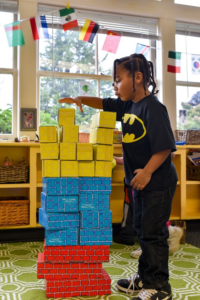Guest Blogger, Katy Allaback GAPS Early Learning Program: Fostering Concentration in the Young Child
It’s true! Three-year-olds are the leaders of concentration in our preschool classrooms. While the active four and five-year-olds often enjoy building relationships and engaging in lots of conversation, the threes are the ones who show us what slowing down and noticing detail looks like. Last week I observed one of our youngest telling a story to herself with some clay, a pile of small rocks, and miniature plastic animals for forty minutes. Another engaged in paint color mixing for the entire Indoor Discovery time, using a palette and thin watercolor brush. Yet another three-year-old placed emerald green gems in groups of 10 all along the edge of the huge circular classroom carpet (Yes–repeated addition which will form the basis of multiplication later on!)
My colleagues sometimes appear skeptical when I describe the intense focus of a young preschooler. However, our preschool staff witness this behavior every day. In the Greater Albany Public Schools (GAPS) preschools, we practice the Inquiry Approach to Teaching and Learning. We believe a teacher’s role is to facilitate learning by setting up engaging opportunities for children to think, predict, wonder, and imagine. The three-year-olds in our multi-age preschools are the ones who often demonstrate focused attention on a particular object or activity.
Using the natural sciences and expressive arts as particular subjects of inspiration, our staff enjoy offering open-ended questions, intriguing dilemmas, and attractive environments to nurture the young child’s concentration. In the picture below, the child uses a light table to decorate a mandala design with various materials–small lavender flowers, gems, buttons, and rocks. She creates a pattern with the items, which is not only a foundational literacy and numeracy concept but also provides a sense of order for young children.
In the second photo, two preschoolers use real working binoculars for bird watching. With a magnified view of the birds, the children enjoy using Oregon bird books to make their nature identifications. Our preschoolers love to bird-watch!
In the third photo below, a child demonstrates concentration while building a structure with care. It appears that he is trying out an idea or responding to a personal challenge as he uses the blocks to construct. I want to believe that the rest of the classroom community respects this child’s efforts, and won’t be tempted to destroy his building!

In this Age of Distraction, in which interruptions are a constant part of life, our staff thinks it’s important to create space for our young children to think, wonder, and imagine. Since we see this focused attention with the youngest in our program, I regularly think about our zero to three year-olds, and their developmental need for the time and space to concentrate. Babies become mesmerized watching leaves move on trees or rainfall on the sidewalk. Although a baby will not be able to focus on the details of the outdoor scene, we know that a lot of concentration is involved in the observation. What important connections must be developing inside the baby’s brain!
There are times when we all feel bombarded by text notifications, phone calls, emails, and all the “breaking news” in our daily lives. These constant interruptions can agitate our minds, and deplete our emotions. Our youngest children are particularly vulnerable to the effects of interruption, as their brains are developing their internal architecture at the fastest rate of their lives! Fortunately, as the adults in our children’s lives, we have the power to safeguard this critical brain development by fostering concentration every day.
Below are some ideas on how to foster concentration in young children:
- Avoid screen time.
- Observe the child. What interests her? What attracts and holds her attention?
- Avoid interrupting the child when engaged in learning.
- Ask open-ended questions, and give your child time to answer and think about the question: “Tell me about the blocks you are using” encourages more concentration (and language!) then “What color is that block?”
- Avoid giving rewards. Playful inquiry is its own reward!
- Consider the concept of “sharing” and what it means for young children. If one child is working diligently on a project, it may not always work to have another child come and join in.
We are all aware of the growing mental health struggles of youth since the pandemic began. Let’s work together to help foster concentration, especially with our youngest children, so they grow up feeling engaged and connected to the world around them!